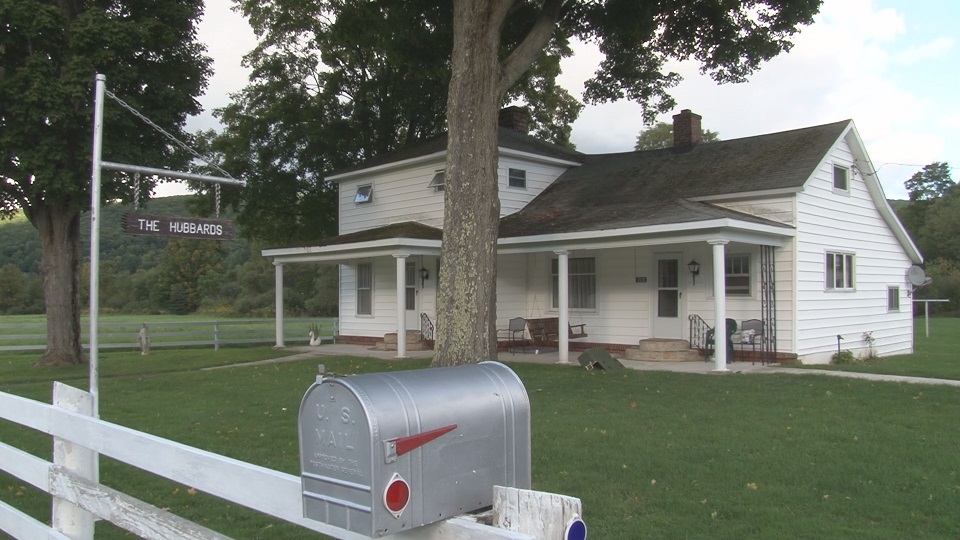RED HOUSE, N.Y. – The state park destroyed most of it. Then came the dam, then the Interstate, and, eventually, the bulldozers. In Red House, even the red house is gone.
Sure, there's still a town hall in Red House. It's a small, unremarkable white structure, hidden at the bottom of the same mountains once used by Native Americans as a burial ground. A smattering of classical, nostalgic farmhouses, spaced comfortably along a one-mile stretch of Bay State Road, still remain, too, including the childhood home of a former NFL running back.
But not much of Red House is man-made anymore. The post office, the schoolhouse, the inn, the chemical plant and the lumber railroad have all been erased from memory, without even the slightest bit of remaining evidence to suggest they ever existed.
On Monday, the demise continues. Contractors will demolish one of the oldest homes in the town.
Llewellyn France, who was born here 83 years ago, remembers visiting that house as a child during the tail end of the Great Depression. Even then, Red House was in decline.
"I always refer to this as the rise and fall of Red House," France said. "Now, we're down to almost nothing."
People do still live here. There are only 38 of them, but they're still here, living peacefully near Interstate 86 in the scenic Allegheny Region, 30 miles east of Jamestown and 70 miles south of Buffalo.
Red House has the smallest population of any town in the state of New York. About a quarter of the town's population holds public office. The France family has occupied the highway superintendent's position since 1944. The two town judges, Lance and Ann Marie Anderson, are a married couple who sometimes get middle-of-the-night phone calls asking them to arraign low-level criminals for sneaking alcohol into Allegany State Park. The Andersons, who have three children, represent about one-eighth of the population, and they have enormous influence when it comes to elections in the Town Justice race.
"I'm a much nicer judge than she is," Lance Anderson said, "but we do have two judges."
The history of the Town of Red House sounds like a sad story. It's not, really. People moved away, and the government leveled homes, but that just means there's now more space for everyone else.
"Look around," Anderson said. "Thirty-eight people in a park that's around 65,000 square acres. It's like we have the whole park that's our backyard."
Funny how that works: the people who live in the smallest town in New York also happen to live in the largest state park in New York.
Admittedly, Anderson thought he'd move away from Red House, back when he completed his undergraduate degree at the University of Miami. He figured South Florida might suit him better, but every time he visited his parents in Red House during the summers, he got hooked all over again.
"I used to sit in class and look out the window," Anderson said. "I used to always think, 'boy, if I could just get back to Red House and the Allegheny Region, where there are trees -- not palm trees, but really nice trees -- that's really a good place to live.'"
Luckily, during one of those return visits to Red House, Anderson met his future wife. They bought his parents' house and stayed for good. Anderson has now logged almost six decades in Red House, which is impressive, but not as impressive as Llewellyn France's record.
France lives in one of the first homes on Bay State Road, a nice, spacious spot with a covered front porch. Eighty-three years ago, he was born just down the road at his grandmother's house, where his family decided to nickname him "Hook," for reasons unknown even to him.
"I never did learn how to spell my regular name until I was in eighth grade," France said. "Too many 'L's."
Hook France left Red House briefly, spending three years in the Army from 1948 to 1951. But, like many of his neighbors, he returned, never to leave again. In 1965, the state tried to kick him off his property, but he hired a lawyer, took three trips to Albany and successfully fought to keep control of his property in Red House.
France retired as a state parks policeman in 1984. These days, his daughter lives next door to him, and he's about as deeply entrenched in a town as a man could be. Before the Civil War, France's great-grandfather built a sawmill and a home on this land, leaving behind his old residence in Salamanca. When it was time to move, he built a raft and transported all his furniture on water.
The sawmill and lumber industry fueled the brief rise of Red House, which held its first board meeting in 1869. Civil war veterans flocked here to start a new life, eager to take advantage of the Allegheny Region's vast resources. During the late 19th century, the population surged to more than 1,000 people. When the state created Allegany State Park in the early 20th century, though, the government seized a lot of properties in Red House. The Kinzua Dam later sprouted up in the mid-20th century, which further intruded on the town. Year by year, the population dwindled.
Then, it reached 38.
"That's 38 if my kids are here," Anderson said. "Sometimes, they go off to school, so it drops down a couple of numbers."
The Andersons and their children form one of the core families of Red House, just as Hook France and his daughter keep the tradition alive in their homes at the front of Bay State Road, named for the Bay State Lumber Company that once operated here.
Beyond the creek, just a few hundred yards away from town hall, the Hubbards form another classic family on Bay State Road. Unfortunately, their white farmhouse, with "THE HUBBARDS" sign still very much intact, often sits empty these days, because the remaining Hubbard lives with her daughter now. Family members come to visit the property every so often, but it's now a historical landmark of sorts. That's because it was once the breeding ground for "Marvelous" Marvin Hubbard, who played football at Randolph High School, then Colgate University, and then the Oakland Raiders and the Detroit Lions.
The three-time Pro Bowl running back still makes an appearance every so often in his old hometown.
"Really good guy," Anderson said. "Great athlete. And every once in awhile, he'll show up here. We'll see him and it's kind of an honor to see him back in town."
Red House used to get famous visitors, too. Anderson said Tim Horton used to spend his weekends in the Red House area to hunt, often showing up on the Anderson property because he liked their small pond in front of the house.
And then there are the ghost stories.
"I don't know anything about ghosts," France said. "Really, I don't."
France, perhaps the most trustworthy historian in Red House, would rather focus on the town's real history. He's not a fan of the supernatural. Somehow, though, Red House has gained a strange reputation for ghost stories, including the one circulating on the World Wide Web about that actual red house in Red House.
About a century ago, even before France was born here, there really was a red house. France notes that the red house was some kind of restaurant or cafe, just along the shores of Red House Creek. All he knows is that it existed at one point, and then it got wiped out.
The Internet, of course, begs to differ. Like a game of Telephone, someone wove a fascinating tale of a lovers' quarrel in the red house of Red House. Long ago, they say, a man died in the Civil War, and his widow ended up marrying his brother. This angered the family, so, like Romeo and Juliet, the lovers took their own lives. And their ghosts apparently haunted the red house forever.
"Some people talk about ghosts all the time," France said, shaking his head.
Anderson hasn't heard that story either.
But he's heard other ghost stories— the ones of the mountains.
"At one time, there was an Indian burial ground atop the mountains, so a lot of people say if they walk up there and hike up there, they'll see orbs up at the top of the hill," Anderson said. "I've never seen any orbs at the top of the hill. But I've never walked up there at night either."
[And] every once in a while, someone will say they see Big Foot. Then, the next day they're in court for consumption charges."
Before there were ghosts, however, there were people. Although the town didn't officially hold a board meeting until after the Civil War, France said the first settler arrived here in 1827. A guy named Darius Frink built a log cabin, and from there, people slowly began to gravitate toward the lumber and sawmill industry in Red House.
The peak of the 19th century didn't last very long, though.
Lately, the fall of Red House seems to have accelerated. Look no further than the huge bulldozer in the front lawn of the abandoned home, the one that's about to meet its fate on Monday. To its credit, the property has received a lot of last-minute visitors. There was the woman who pulled over to the side of the road, walked out of her car and began snapping photos of the old house, which mostly consists of broken windows and faded paint nowadays.
"Some of these were grand, old farmhouses of the 1800s and early 1900s," Anderson said. "And just to go down the road and travel though what's left of Red House, and to see houses being torn down by the state… you actually physically see that happen. You actually physically see the house being demolished. Everyone visited everyone else. We're all neighbors. So, to see those houses being torn down, it's kind of disheartening."
Disheartening, yes. But the people of Red House have seen this before.
These are the same people, after all, who don't have a post office anymore— they all have mailing addresses classified to nearby Salamanca, N.Y, located 10 miles away.
It hasn't been easy for Hook France to watch his childhood slowly disappear for 83 years. Monday's demolition is a gut-punch, but that's all it is. In a few months, when the leaves fall off the trees and the snow begins to pelt the Red House area, France will hop in his snowplow and clear the roads, just as he's done for 30 years, and just as his father did for 40 years before him.
"Smallest town in New York," France said, sighing. "But we still make it as our own here."


